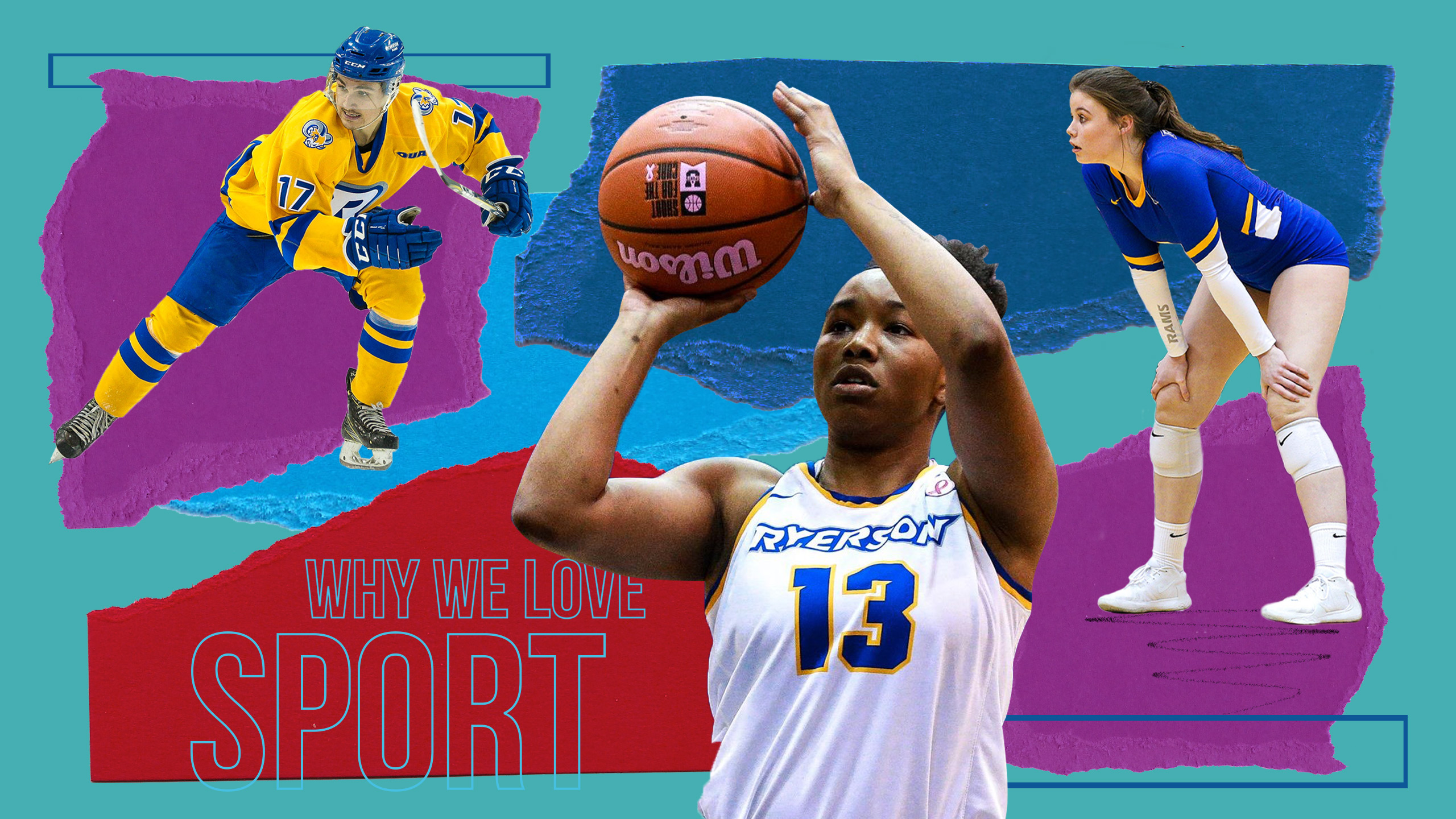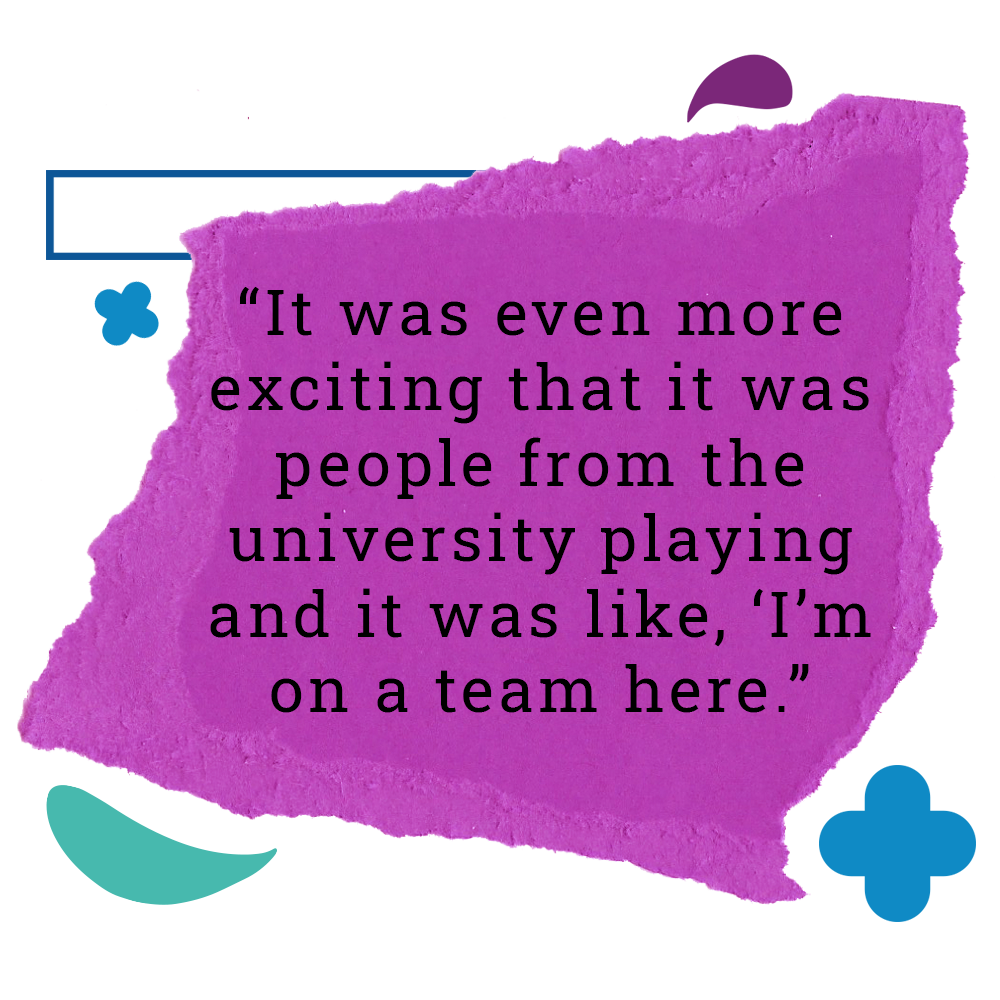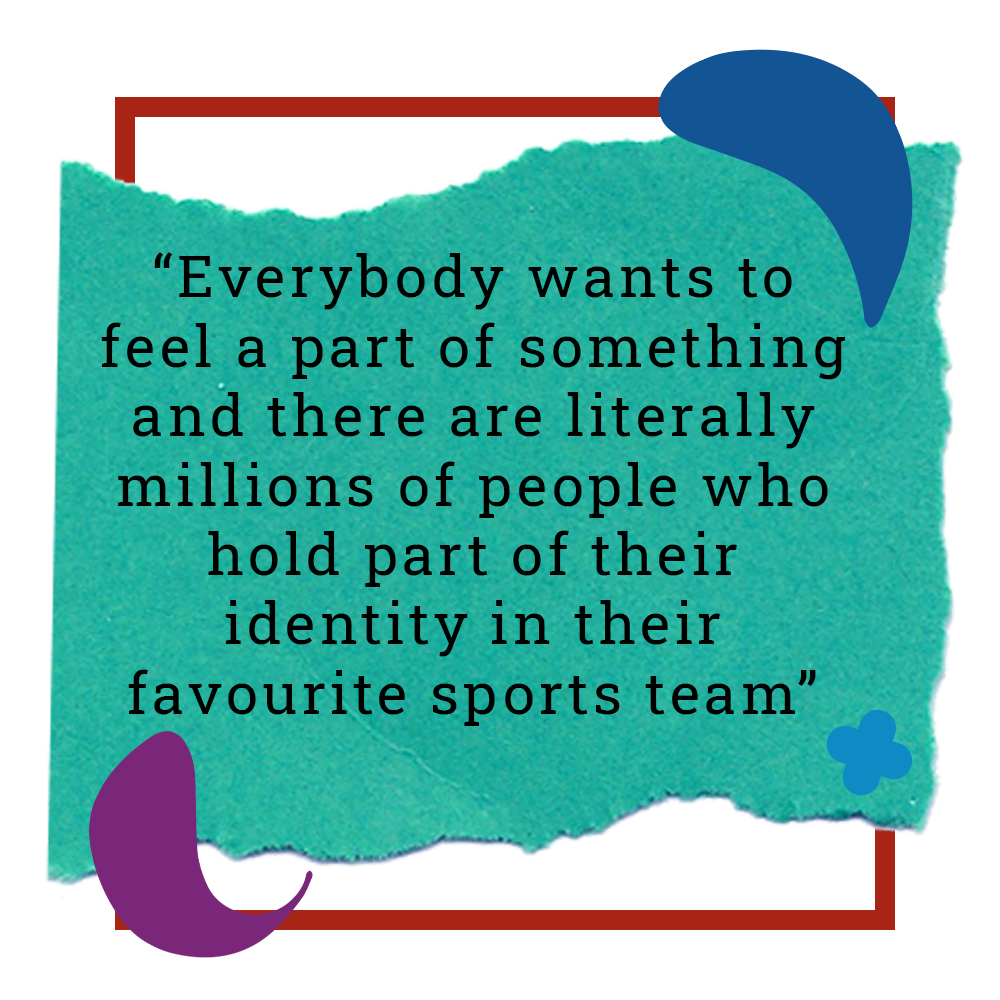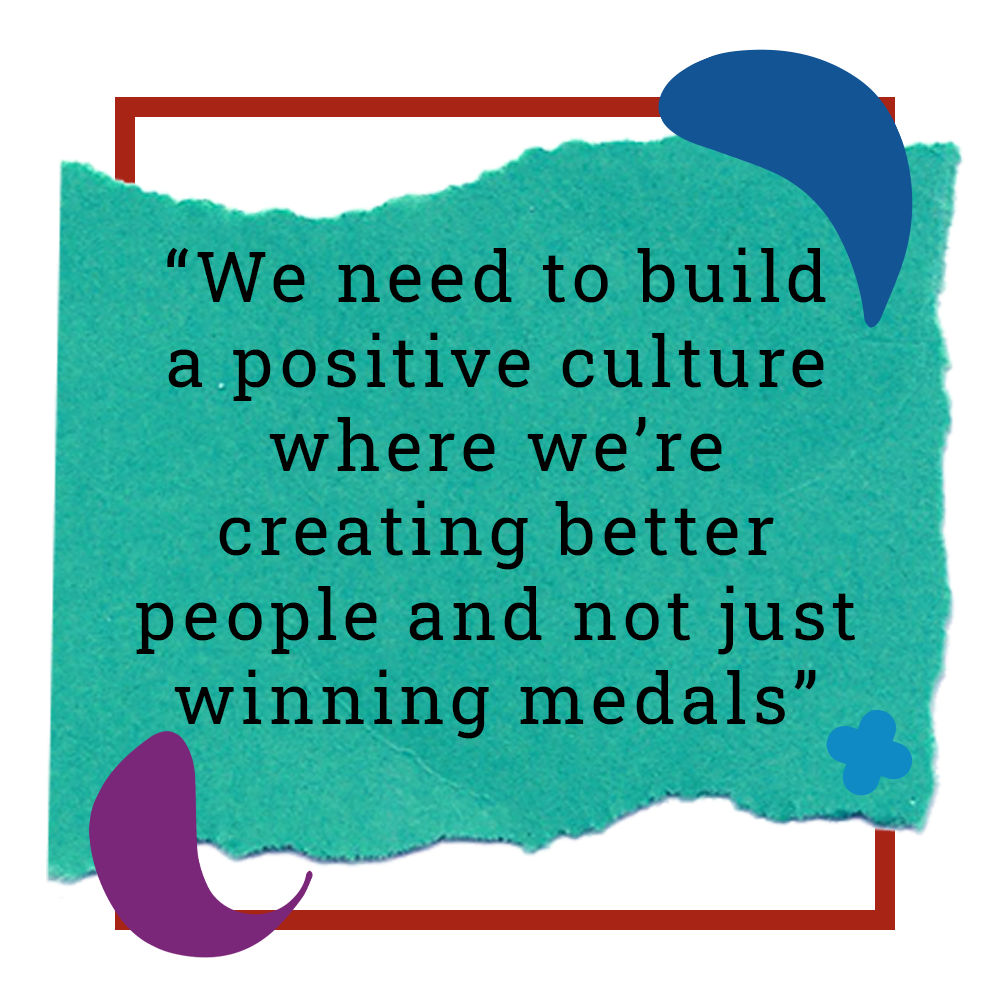
More than the game: Why we love sports
From fans to athletes to media members, a look at what makes us love sports
The crowd inside the Mattamy Athletic Centre (MAC) roared as the Ryerson Rams men’s hockey team took to the ice to open their season. Homecoming had been promoted as a marquee event and most of the plastic blue seats were filled with fans decked in the university’s blue and yellow colours.
It was the first time that then-first-year creative industries student Maya Abou-Jalala had ever been to a hockey game. The glimmer of the freshly cleaned ice caught her eye, and as the lights in the arena faded to black, she felt a rush of nervous excitement building in her stomach.
Weeks earlier, Abou-Jalala had moved to Toronto from Doha, Qatar. The atmosphere inside the MAC, which she compared to a full-scale production, was unlike anything she’d ever experienced.
Although she didn’t know the rules of the game, being in the arena and wearing her yellow Ryerson Rams shirt made her feel like she belonged. Being a part of a community is one of her favourite things about sports, she says.

The crowd inside the Mattamy Athletic Centre (MAC) roared as the Ryerson Rams men’s hockey team took to the ice to open their season. Homecoming had been promoted as a marquee event and most of the plastic blue seats were filled with fans decked in the university’s blue and yellow colours.
It was the first time that then-first-year creative industries student Maya Abou-Jalala had ever been to a hockey game. The glimmer of the freshly cleaned ice caught her eye, and as the lights in the arena faded to black, she felt a rush of nervous excitement building in her stomach.
Weeks earlier, Abou-Jalala had moved to Toronto from Doha, Qatar. The atmosphere inside the MAC, which she compared to a full-scale production, was unlike anything she’d ever experienced.
Although she didn’t know the rules of the game, being in the arena and wearing her yellow Ryerson Rams shirt made her feel like she belonged. Being a part of a community is one of her favourite things about sports, she says.

For some, finding community comes in the world of traditional sports, but for others, it’s computers, controllers and consoles. New York’s iconic Arthur Ashe Stadium, a place where tennis legends like Serena Williams and Roger Federer usually take centre stage, hosted the 2019 Fortnite World Cup. That year, 16-year-old Kyle Giersdorf, better known as “Bugha” in gaming circles, made national headlines by winning the solo tournament and taking home a $3 million cash prize.
According to the developer behind Fortnite, Epic Games, 19,000 fans turned out for the three-day tournament in New York City. In addition, viewership peaked at 2.3 million across platforms like YouTube and Twitch.
“[People were saying,] ‘this kid won all this money and all he did was play Fortnite? Oh my god, maybe we should be paying attention to this,’” said TSN Digital SportsCentre host and avid esports supporter Marissa Roberto.
You don’t need to be able to lift weights, run fast or hit home runs to pick up a controller. Streaming platforms like Facebook, YouTube and Twitch make it as easy as the click of a button to go online and interact with thousands of like-minded fans for free. Through esports, those who grew up outside the realm of physical sports due to alienation or disinterest are still able to engage with all the traditional tenets of sports culture, including the community.
Going to an esports event is much like going to watch your favourite sports team—right down to the part where you buy a stadium beverage and later ask yourself why you paid $10 for a Coke. It’s the familiar smells of hotdogs, popcorn and cotton candy too.
Even though everything you’re watching is on a screen, there are duelling chants between fans and beach balls flying through the crowd. You might even strike up a conversation with the person next to you, not because you know them, but because you both love what you’re watching.
Esports is bleeding into mainstream culture, with professional sports leagues starting to get involved. The NBA became the only one of the big four North American sports entities to create its own gaming offshoot in 2018, and 23 of 30 franchises are represented in its NBA 2K League. The Toronto Raptors have a team called Raptors Uprising Gaming.
Despite the stereotypes about gamers—being basement dwellers or having neckbeards, or being lazy—the reality is there are millions of people who’d rather battle in Pokemon Stadium than get tackled on a football field.

“I still want people to learn that esports is something valuable," said Roberto. "If you follow any of these scenes on [social media,]—like Call of Duty, CS:GO, the Smash Bros. community—they’re all so unique and they offer something very special. You just have to take the time to get to know them.”

As a child, the basketball court with the lowered hoop in his friend’s driveway became a space of unlimited creativity for Cabbie Richards. Before Richards rose to Canadian sports television fame, best known for his time on SportsCentre and The Score, he was soaring through the air with his tongue out like Michael Jordan and dunking with his eyes covered like Dee Brown.
Richards believes sports are tethered to a person’s identity and that some people’s livelihoods depend on the performance of their favourite teams. One example of identity within sports fandom is the Chicago Cubs, also known as the “loveable losers,” he said.
In 2016, the Cubs won the World Series, Major League Baseball’s (MLB) championship, for the first time in 108 years. The team had come close to winning many times during their more-than-a-century long drought, but they could never quite get the job done. Finally, on Nov. 2, 2016, they defeated Cleveland in a marathon-like seventh game, which required an extra 10th inning and had a 17-minute rain delay.
“Could you imagine that, like, ‘Finally we won!’ The euphoria was probably amplified because the team was unsuccessful for so long,” said Richards. “The pride those fans felt because their team won, it’s ingrained in their DNA.”
An estimated crowd of five million people turned out for the Cubs’ championship parade in Chicago days later.
“Everybody wants to feel a part of something and there are literally millions of people who hold part of their identity in their favourite sports team,” said Richards. “That’s where they find community, that’s where they find value.”
According to a 2016 study in the European Sport Management Quarterly on the role of rivalry in sport, being part of a fan group can help fulfill two basic needs: group belonging and distinctiveness from others. Since there are many different sports teams to cheer on across a number of leagues, fans are able to fulfill both needs by joining contrasting fan groups.
Finding an identity isn’t limited to sports fan communities though, it’s also found through being an athlete.
Former Canadian Women’s Hockey League (CWHL) player Jessica Platt knows firsthand what it’s like to find yourself within sport, even if it didn’t previously make room for you. She became the first transgender professional women’s hockey player in North America after publicly coming out via Instagram in 2018.
The 31-year-old never intended to come out publicly, but she soon realized her platform as a professional athlete could bring about needed social change. Being a role model is something she considers an honour.
“I’m happy to be able to speak for people who don’t have a voice or can’t speak up because of their circumstances,” said Platt. “I always want to make the future better for people who are going through similar experiences as me. I just want them to see that they can do it too”
Platt fell in love with hockey on the backyard rink in her hometown of Sarnia, Ont. She played until the end of high school, but during that time she began to feel differently than everybody else in the locker room and it became an unsafe space.
She recalled how the only openly gay man at her high school was made fun of maliciously at hockey practices even though he wasn’t involved with any teams. At a time when most of her teammates were trying to find a way to extend their careers through junior or college hockey, she stepped away from the game. Her days of skating freely through the cool arena air might have ended, but stepping away from hockey is what helped Platt realize what she had to do to make herself happy.
“Anyone seen as different was made fun,” said Platt.
Platt’s hiatus from the game lasted until 2016. She wanted to explore her options within women’s hockey first by joining a recreational league, then working her way up to apply for the CWHL draft. Platt was selected 61st overall by the Toronto Furies that year.
Two years later, Platt found herself in the locker room before practice with a script in hand, ready to tell her teammates her truth. She’d already come out to the league and her coaches, but she worried telling her teammates would once again make her the outcast on her team.

Platt recalled how nervous she was as she read her script, stepping out of the locker room to let her teammates digest the information when she was done. Soon after, her teammates found her in the hall. “Alright, so you coming to practice?” one asked. Platt could finally silence the voice of doubt in her head that kept asking “what happens if someone finds out you’re transgender?”
“It was the hugest relief ever, I didn’t know how they were gonna react and to get the positive reaction, to know that nothing had changed, was everything I had wanted,” said Platt.
“I felt super relieved and unburdened.”
The CWHL shut down in 2019, but it hasn’t stopped Platt from continuing to fight for equity in hockey. She hopes to see a day where the sport can be truly for everyone, as it often claims to be. “There’s too much racist, homophobic, transphobic [and] just overall negative language in hockey, that needs an overhaul.”
In order for athletes to really find themselves in sport, the right environment has to be cultivated by coaching staff and management.
Sport Manitoba interim president and CEO Janet McMahon has been a prominent face in youth sport for decades. She’s coached players in basketball, soccer and volleyball from when they’re just learning how to play all the way into their late teens.
McMahon, a former basketball player at the collegiate level, is quick to dispute the notion that every athlete can become a good coach. She recalled how she didn’t really understand how even the smallest of word choices could affect an athlete until she became a parent.
“I was never a ‘win at all costs’ coach. It’s way more important for kids to have a positive experience, to build confidence rather than becoming a phenomenal athlete winning every single game,” said McMahon.
Part of McMahon’s role in her current position is to consider how to change the way sports are taught. Her tip for aspiring “bench bosses” is to think about something a coach of theirs did that they didn’t like and how they’d act to make sure the cycle doesn’t repeat itself.
“We need to build a positive culture where we’re creating better people and not just winning medals,” said McMahon.

Research shows that developing a strong athletic identity can be beneficial to one’s sense of self and translate into other aspects of an athlete’s life. A 2019 article for Frontiers in Sports and Living found scholar-athletes dedication to their sport translated into achievement in academics and the workplace, stating “academics and athletics are complementary and mutually supportive endeavours.”
“An Athlete diligently practices the skills needed to obtain the physical and mental ‘knowledge’ required to maximize performance in sport,” the study reads. “Much like the traits of a Scholar, the Athlete finds their identity in their daily routine, which includes multiple periods of time set aside to train, practice or compete in their chosen sport. Just as Scholars are careful in how they systematically approach a topic of study, so too does an Athlete carefully consider and study behavioural aspects, such as diet, nutrition, hydration, exercise and performance.”
Further, a 2020 study from the Journal of Adolescent Health found that maintaining an athletic identity through the pandemic in spite of the cancellation of sports was beneficial to college athletes’ wellbeing. While interruptions in routine and major life changes, like COVID-19, can be threats to a person’s sense of identity, the studies’ findings aligned with “research demonstrating that maintaining positive social group memberships following major life events can buffer against declines in well-being,” the study reads.

Social connectedness and social support from teammates were key factors in allowing athletes to maintain feelings of belonging and reaffirm their identification as athletes. According to the study, “student-athletes who felt more supported by their teammates during COVID-19 tended to experience identity gains, and in turn, tended to report greater psychological well-being as well as lower depressive symptoms.”
For Ryerson Rams men’s basketball guard Tyler Sagl, dedicating himself to his athletic identity has given him the motivation to never stop improving. On the court, he can shoot the lights out in a gym and dazzle you with dribble moves, but off the court, he’s his own fiercest competition.
“You’re never perfect, there’s always something to improve on,” said Sagl. “You have something to chase forever, in a sense.”
The second-year guard has always considered himself to be a hard worker, but meeting NBA legend Scottie Pippen in 2018 injected him with a boost of motivation that’s fuelled him ever since.
At the time, Sagl played for a club team called UPlay Canada. They made the trip to sunny Los Angeles for a series of Nike Elite Youth Basketball League (EYBL) games. The EYBL is made up of elite club teams across North America. The amount of future basketball stars on display makes college coaches and scouts salivate.
During the trip, Sagl’s team faced the Oakland Soldiers, where Pippen watched his own son play from the sidelines. Sagl remembers the intensity of the game and how it was a dogfight right until the end when his team squeezed out a three-point victory.
Pippen has seen thousands of basketball games in his lifetime, but on that day it was the young star from Burlington, Ont. who caught his attention. The basketball Hall of Famer approached a sweat-drenched Sagl after the game to offer him words of encouragement.
“He came up to me and said that I have a lot of potential…it just gave me a lot of motivation to
work even harder than I already was because of who he is,” said Sagl.
The chase for perfection is a shared bond between Sagl and his close friend and Rams teammate Marcus Upshaw.
Upshaw knows what it’s like not to be the first, second or even third option on a team. In fact, growing up he was often the last guy to come off the bench. It can be hard to get minutes on the court when you’re a late bloomer playing on a team with 2018 third-overall NBA Draft pick RJ Barrett.
Coming out of high school, Upshaw only had two scholarship offers, but three years later, he finds himself playing for the Rams, one of the best programs in the country. It’d be easy to get comfortable in his current position, but like Sagl, he knows the chase never ends. For both players, sports gave them an avenue for personal growth and development. Finding themselves on the court remains the motivation to keep growing off it.
“It’s an imperfect game that people try to make perfect…you’re never really at a standstill in basketball,” said Upshaw.

For some, sports are part of their personal identity. They can be a place of belonging, or a platform to take a stand. People can find themselves within their teams, within their athletic journey or even in the community of fans. The highs of sport pull us together and its lows pull us apart, but when the whistle blows and the buzzer sounds, it will always keep people coming back for more.
That’s why we love sports.